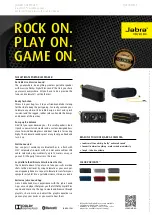
- 8 -
1. SAFETY INSTRUCTIONS
Before using the generating set it is necessary to read the generating set and alternator ”Use and Maintenance
Manual” and to follow the recommendations below.
⇒
Safe and efficient performance may be achieved only if the machines are used correctly, in compliance
with the instructions provided by the relevant use and maintenance manuals and safety regulations.
⇒
An electric shock may cause serious personal injury or even death.
⇒
Do not remove either the terminal board cover or the alternator protection grid before the alternator
has come to a complete stop and the generating set starting system has been deactivated.
⇒
Only competent and qualified personnel should carry out the maintenance of the generating set.
⇒
Do not wear loose garments when working near the generating set.
⇒
People in charge of operating the set must always wear protective gloves and safety shoes. In the event
that the generator, or the whole generating set, needs to be lifted from the floor, the operators must
also wear a safety helmet.
The person responsible for the installation of the generating set must make sure that all the necessary
safety arrangements are in place in order to make the whole plant compliant with current local safety
regulations (earthing, contact protection, explosion and fire safety measures, emergency stop, etc.…)
Safety warnings. Safety notices used in this manual have the following meaning.
IMPORTANT!
Refers to dangerous or risky operations that may cause damage to the product.
CAUTION! Refers to dangerous or risky operations that may damage the product or cause personal in-
jury.
WARNINg! Refers to dangerous or risky operations that may cause serious personal injury or even death.
DANgER! Refers to an immediate risk that may cause serious personal injury or death.
2. ALTERNATOR DESCRIPTION
The E1S series includes three-phase 2/4 poles alternators with brushes equipped with an auxiliary winding (loaded on a
compound) which ensures voltage regulation.
They are manufactured in compliance with
EN 60034-1, EN 60204-1, EN 55014-1, EN 55011, EN61000-6-2, EN 61000-6-4
specifications, as well as with the
2006/95/CE, 2004/108/CE, and 2006/42/CE
directives.
Ventilation:
Axial with air inlet on the non-drive end side .
Protection.
Standard IP 21. IP 23 on request.
Direction of rotation.
Both directions are allowed.
Electrical features.
Insulation components are made with class H material, for both stator and rotor. Windings are
tropicalized.
Power values.
They refer to the following conditions: ambient temperature up to 40°C, altitude up to 1000 m. above sea-level,
continuous duty at Cosф= 0.8.
Overloads
A 10% overload for one hour every six hour is normally accepted.
Mechanical features
Casing and covers are made of aluminium alloy which holds out against vibrations. The shaft is made of high-tensile steel.
gUASTO
CAUSE
INTERVENTI
Alternatore non si eccita
1) Insufficiente tensione residua
2) Interruzione di un collegamento
3) Ponte a diodi rotante guasto
4) Velocità insufficiente
5) Guasto negli avvolgimenti
6) Cattivo contatto con le spazzole
1) Eccitare il rotore utilizzando una batteria
2) Ripristinare il collegamento
3) Sostituire il ponte a diodi
4) Intervenire sul regolatore di giri del
motore primo
5) Controllare le resistenze e sostituire la
parte avariata
6) Pulire e controllare il collettore ad anelli
Tensione a vuoto bassa
1) Velocità ridotta
2) Cattivo contatto delle spazzole
3) Avvolgimento guasto
4) Ponte a diodi guasto
1) Riportare il motore prima a velocità
nominale
2) Controllare, pulire o sostituire le
spazzole
3) Controllare la resistenza e sostituire la
parte in avaria
4) Sostituire il ponte a diodi
Tensione corretta a vuoto, ma
troppo bassa a carico
1) Velocità ridotta a carico
2) Compound guasto
3) Avvolgimento del rotore difettoso
4) Carico troppo elevato
1) Intervenire sul regolatore di giri del
motore
2) Controllare ed eventualmente sostituire
il compound
3) Controllare la resistenza dell’ avvolg. del
rotore e, se guasto, sostituire il rotore
4) Intervenire sul carico per ridurlo
Tensione corretta a vuoto, ma
troppo alta a carico
1) Presenza di condensatori sul carico
2) Compound guasto
3) Collegamento delle fasi errato
1) Ridurre il carico capacitivo
2) Controllare ed eventualmente sostituire
il Compound
3) Controllare e correggere il collegamento
delle fasi
Tensione instabile
1) Massa rotante troppo piccola
2) Velocità irregolare
3) Cattivo contatto sul collettore
1) Aumentare il volano del motore primo
2) Controllare e riparare il regolatore di giri
del motore primo
3) Pulire e controllare il collettore ad anelli
e le spazzole
Funzionamento rumoroso
1) Accoppiamento meccanico difettoso
2) Cortocircuito su qualche avvolgimento
3) Cuscinetto difettoso
1) Controllare e/o modificare
l’accoppiamento
2) Controllare gli avvolgimenti e/o il carico
3) Sostituire il cuscinetto
ENgLISH
Содержание E1S10L L
Страница 3: ...3 1 A B Mod L mm E1S10 2 E1S11 2 E1S13 4 2 A B 3 A B 4 A B 5 A B 6 A B 7 A B...
Страница 4: ...4 12 8 9 10 11 A B A B...
Страница 23: ...23 PARTI DI RICAMBIO SPARE PARTS LISTA DE REPUESTOS PIECES DETACHEES ERSATZTEILE...
Страница 24: ...24 E1S10M E1S10L...
Страница 26: ...26 E1S13S 2 E1S13S 4 E1S13M 2 E1S13M 4...
Страница 28: ...28 E1S11M...
Страница 30: ...30 NOTE...
Страница 31: ...31 NOTE...









































